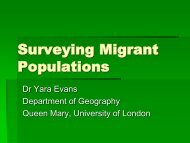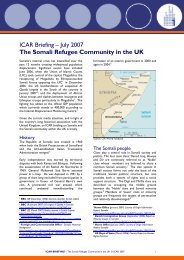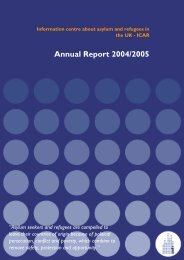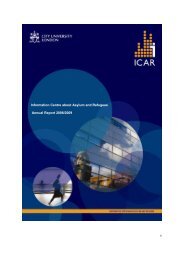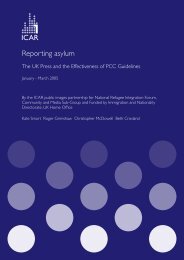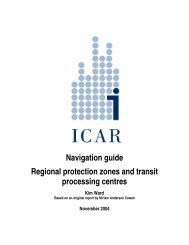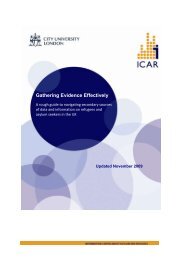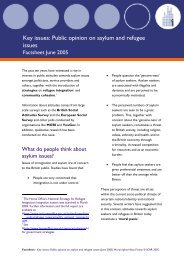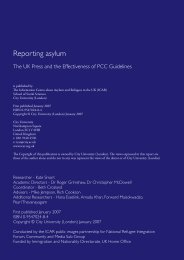Uncovered: assessing media and communications needs ... - ICAR
Uncovered: assessing media and communications needs ... - ICAR
Uncovered: assessing media and communications needs ... - ICAR
- No tags were found...
Create successful ePaper yourself
Turn your PDF publications into a flip-book with our unique Google optimized e-Paper software.
Refugee <strong>and</strong> migrant <strong>and</strong> faith groups are more likely to want to focus on the need to counteradverse publicity from the <strong>media</strong>. Research by the Information Centre about Asylum <strong>and</strong> Refugees(<strong>ICAR</strong>) 19 suggests that local <strong>media</strong> rather than the national <strong>media</strong> is more likely to consider the impacton community relations in their reporting, suggesting that local <strong>media</strong> should be the focus of suchactivities. Training aimed at improving underst<strong>and</strong>ing <strong>and</strong> fostering relationships with local journalistsmay therefore be of interest to these groups as well as having the ultimate potential of bringingcommunities together.Questionnaire respondents provided further examples relating to the purpose of their publicity,many of which might be termed awareness/profi le-raising such as ‘promoting our success’ <strong>and</strong>‘encouraging curiosity’. Others wanted to ‘prevent stigma’, ‘regain our voice’, ‘counter racism’ <strong>and</strong>‘restore balance to reporting’.Other examples included increasing membership, infl uencing policy <strong>and</strong> encouraging use of services.One said s/he wanted to ‘set agendas’ <strong>and</strong> another to encourage recruitment of trustees.Fig 7.3.10 Communications strategyOnly a minority of organisations surveyed reported that they had a <strong>communications</strong> strategy. Amongstrefugee <strong>and</strong> migrant worker, BME <strong>and</strong> faith groups the percentage was less than half. Respondentsin the ‘isolated rural’ category were the only ones where the majority of organisations have a strategy.This could be attributed to the structural development <strong>and</strong> size of rural infrastructure organisations,which are larger <strong>and</strong> more established, <strong>and</strong> also to a lack of knowledge <strong>and</strong> confi dence in developinga strategy; this would be a further area of training need.“Only a small proportion of voluntary organisations budget for training <strong>and</strong> support, or have aproactive <strong>communications</strong> strategy. Most don’t think about it until there’s a crisis. Then they have toreact suddenly.” – (civil servant)19 “Reporting Asylum: The UK press <strong>and</strong> the effectiveness of PCC guidelines – March 2007. http://www.icar.org.uk/?lid=477524 <strong>Uncovered</strong>: <strong>assessing</strong> <strong>media</strong> <strong>and</strong> <strong>communications</strong> <strong>needs</strong> <strong>and</strong> capacity of marginalised communities





